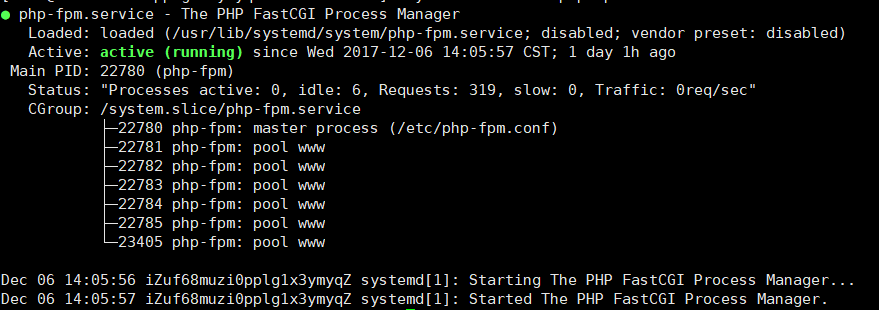** 1. Turn off firewalls and selinux --------------- **
Close Firewall
[root@localhost ~]# systemctl stop firewalld.serviceselinux
[root@localhost ~]# vim /etc/sysconfig/selinux Find SELINUX=enforcing and change enforcing to disabled [root@localhost ~]# setenforce 0
** 2. Install nginx --------- **
wget download install nginx package
[root@localhost ~]# wget http://nginx.org/packages/centos/7/noarch/RPMS/nginx-release-centos-7-0.el7.ngx.noarch.rpmEstablish a yum repository for nginx
[root@localhost ~]# rpm -ivh nginx-release-centos-7-0.el7.ngx.noarch.rpminstall & start nginx
[root@localhost ~]# yum install -y nginx
[root@localhost ~]# systemctl start nginx.service** 3. Install mysql ---------- **
Download repo resources
[root@localhost ~]# wget http://repo.mysql.com/mysql-community-release-el7-5.noarch.rpmInstall mysql-community-release-el7-5.noarch.rpm
[root@localhost ~]# rpm -ivh mysql-community-release-el7-5.noarch.rpmInstall MySQL &Set User Rights &Restart
[root@localhost ~]# sudo yum install -y mysql-server
[root@localhost ~]# sudo chown -R root:root /var/lib/mysql
[root@localhost ~]# systemctl restart mysql.serviceLog in to MySQL and change your password (you can set it yourself after all installation is complete):
[root@localhost ~]# mysql -u root
mysql > use mysql;
mysql > update user set password=password('123456') where user='root';
mysql > flush privilgegs;
mysql > exit;** 3.PHP7 Installation ------- **
rpm install php corresponding yum resources
[root@localhost ~]# rpm -Uvh https://dl.fedoraproject.org/pub/epel/epel-release-latest-7.noarch.rpm
[root@localhost ~]# rpm -Uvh https://mirror.webtatic.com/yum/el7/webtatic-release.rpminstall php7.0
[root@localhost ~]# yum install -y php70wInstall Extensions
[root@localhost ~]# yum install -y php70w-mysql.x86_64 php70w-gd.x86_64 php70w-ldap.x86_64 php70w-mbstring.x86_64 php70w-mcrypt.x86_64Install php fpm
[root@localhost ~]# yum install -y php70w-fpm**
Modify Configuration
**
nginx profile modification: can be done directly inNginx.confModify, for fear of bad modification, I create a new.conf file in con.d.
user nginx;
worker_processes auto;
error_log /var/log/nginx/error.log warn;
pid /var/run/nginx.pid;
#Specifies the value for maximum file descriptors that can be opened by this process.
worker_rlimit_nofile 51200;
events
{
use epoll;
worker_connections 51200;
multi_accept on;
}
http
{
include mime.types;
default_type application/octet-stream;
server_names_hash_bucket_size 128;
client_header_buffer_size 32k;
large_client_header_buffers 4 32k;
client_max_body_size 50m;
sendfile on;
tcp_nopush on;
keepalive_timeout 60;
tcp_nodelay on;
fastcgi_connect_timeout 300;
fastcgi_send_timeout 300;
fastcgi_read_timeout 300;
fastcgi_buffer_size 64k;
fastcgi_buffers 4 64k;
fastcgi_busy_buffers_size 128k;
fastcgi_temp_file_write_size 256k;
gzip on;
gzip_min_length 1k;
gzip_buffers 4 16k;
gzip_http_version 1.1;
gzip_comp_level 2;
gzip_types text/plain application/javascript application/x-javascript text/javascript text/css application/xml application/xml+rss;
gzip_vary on;
gzip_proxied expired no-cache no-store private auth;
gzip_disable "MSIE [1-6]\.";
#limit_conn_zone $binary_remote_addr zone=perip:10m;
##If enable limit_conn_zone,add "limit_conn perip 10;" to server section.
server_tokens off;
access_log off;
server
{
listen 80 default_server;
server_name "Domain name can also be ip";
index index.html index.htm index.php;
root /forest/www(Change to your own directory for placing code: Custom);
#error_page 404 /404.html;
location ~ [^/]\.php(/|$)
{
try_files $uri =404;
# fastcgi_pass unix:/tmp/php-cgi.sock;
fastcgi_pass 127.0.0.1:9000;
fastcgi_index index.php;
include fastcgi.conf;
}
location /nginx_status
{
stub_status on;
access_log off;
}
location ~ .*\.(gif|jpg|jpeg|png|bmp|swf)$
{
expires 30d;
}
location ~ .*\.(js|css)?$
{
expires 12h;
}
location ~ /\.
{
deny all;
}
access_log /home/access.log;
}
# Load additional configurations
#include vhost/*.conf;
}
Modify php-fpm configuration file
[root@localhost ~]# vim /etc/php-fpm.d/www.conf
Find the change so
user =nginx
group=nginxPrevent a test file in the set root directory
echo 'HELLO VAN!';**
Start Server
**
[root@localhost ~]# systemctl start nginx.serviceView Server Status
[root@localhost ~]# systemctl status nginx 
Start PHP-FPM
[root@localhost ~]# systemctl start php-fpm.service
[root@localhost ~]# systemctl status php-fpm.service 
Enter ip or a bound domain name in the browser and OK!
Ah Moh finally wrote it